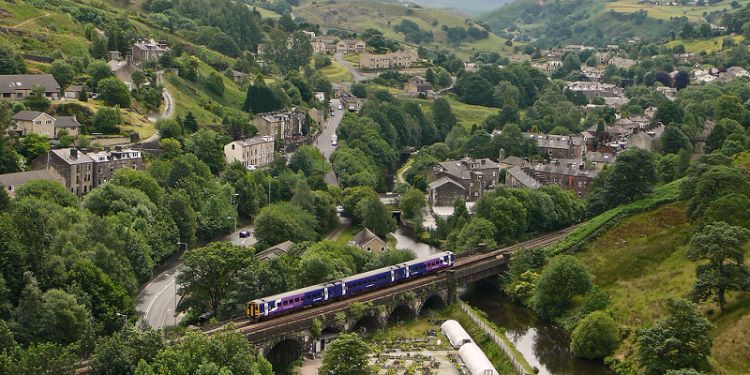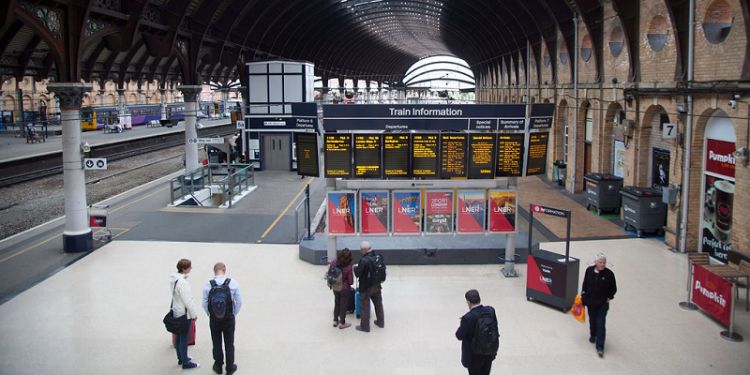New insight into links between transport and land value

A new report reveals the relationships between transport and property value across the North of England.
The report highlights how understanding these relationships can help inform infrastructure planning and investment - from inter-city rail connections to shaping the urban environment.
Researchers from the Institute for Transport Studies at the University of Leeds have developed three new models of the property market in the North of England – an area of 40,000km2 with 15 million people and 7.1 million homes.
The models quantify the extent to which transport links can make locations more attractive to people and businesses. They also include a wide range of other factors contributing to property value, including access to local facilities, schools and green space.
The report, funded by Transport for the North, West Yorkshire Combined Authority and the Engineering and Physical Sciences Research Council, is the first of its kind and the results are being presented at six international conferences this year.
The benefits of being well connected
The study found that across the North there is a premium on being well connected. Ease of access to employment is a key driver of property values, with rail, road and pedestrian accessibility to jobs all adding value.
Rail access alone can add 14% to the value of a home. For every additional 10,000 jobs that are readily accessible by rail, there is a property price premium of 0.16%. There is also a premium of 0.19% per 10,000 jobs accessible by car.
The ability to walk to work has the most significant impact on values, with a property price premium of 3.61% for each additional 10,000 jobs within reach by walking – although the total number of jobs accessible by walking tends to be smaller than by car or rail. This is seen in the 'city centre premiums' in the market, and also points to the value of mixed urban development as the Northern economy grows.
We can now clearly see not only the value urban rail systems bring in the property market, but the value of inter-urban connectivity in the North, and walk accessibility as well as by rail and car.
The report also provides evidence that past transport investment in the North of England has created value in the property market. Using the Manchester Metrolink extensions since 1995 as a case study, the report finds that:
- Metrolink extensions have increased property prices near to the new stations by 6.3% on average;
- the South Manchester Line has increased prices by 10.5% and the Airport Line by 20.9%.
In addition to the effects of transport on property value, the report identified many other factors – some of which can be influenced by public policy, including:
- access to local centres with facilities such as shops and banks, is worth around 7.5% of the value of an average home;
- access to parks and playgrounds can add up to 7% to property value – compared with locations without these features;
- both air quality and freedom from traffic noise add value – measures to completely eliminate noise from busy roads and railways, such as tunnelling for example, can increase the value of nearby properties by as much as 8%;
- measures such as low noise road surfacing and urban greening would make a more modest positive impact; and Clean Air Zones should raise property values across the area of the Zone.
Report lead author Dr John Nellthorp, from Leeds’ Institute for Transport Studies, said: “Previous research has shown there are significant gaps in understanding how transport infrastructure investment can affect land value. Property markets are complex and transport is only one of the elements that can influence prices.
“We can now clearly see not only the value urban rail systems bring in the property market, but the value of inter-urban connectivity in the North, and walk accessibility as well as by rail and car.
“The findings on environment and place quality were not the main goal of the work but do help to put the transport impacts in context. Place quality is important, in fact it is one of the North’s strengths and this report helps us understand how all these elements fit together in driving land value.
“The results of this study can be seen as a boost to the analysis of ‘land value uplift’ and to the case for well-designed investments in regions outside London”.
Informing planning and investment
The study also provided the first estimates of the potential impact of Northern Powerhouse Rail on land value. While the researchers caution that the national economy and fluctuations in the property market can cause additional impact to land value, the initial estimates indicate there is the potential for impacts up to 9.3% in some areas close to the stations – the outcomes will depend upon many factors including the investment response in the supply of new housing and business space.
The research provides a robust body of evidence to help us build the case for investment in transport, and we can use this to inform the case for Northern Powerhouse Rail.
Dr Jack Snape, Principal Data Analytics and Modelling Officer at Transport for the North, said: “This work shows significant increases in land value from improved access to employment by rail, road and walking – which could help to bring forward the investment needed to help tackle the housing crisis and support the growth plans of the North.
“The research provides a robust body of evidence to help us build the case for investment in transport, and we can use this to inform the case for Northern Powerhouse Rail.”
Transport for the North plans to incorporate the report’s findings into an Analytical Framework to help understand how transport investment could help rebalance the economy more evenly around the country.
The framework will be used to examine whether improved transport connections could enable existing buildings and vacant land in the North to be used to their full potential.
An increase in land value in the North could also stimulate other forms of investment, such as new and refurbished housing in places where commuters can easily and sustainably get to work.
Land value plays an important role in government appraisal of transport and regeneration investment and these new models will allow us to paint a more effective and robust picture of those benefits.
Cllr Kim Groves, Chair of the West Yorkshire Combined Authority Transport Committee, said: “This research provides invaluable insight on how local property markets can benefit from transport investment and gives us the means to accurately set out those benefits to the government when making the case for transport investment.
“Land value plays an important role in government appraisal of transport and regeneration investment and these new models will allow us to paint a more effective and robust picture of those benefits. It also gives us the means to monitor the property market across the lifetime of major transport investments to show the potential fiscal benefits of such investments to the government.
“The models developed by the researchers can do this more accurately than has been possible to date and we are working with the Department for Transport to help make sure this work will be used to support the business case for transport investment in West Yorkshire and to show those benefits across the North.”
Further information
Top image credit: Tim Green
The econometric models developed in this study were built using a large, spatially detailed dataset.
The full suite of models developed in the study include:
- a cross-sectional model of residential property values across the whole of the North of England, using hedonic pricing methods and including both accessibility and place quality;
- a quasi-experimental model of residential property values, focusing on the impact of Manchester Metrolink extensions between 1995 and 2018, using panel data (cross-sectional and time series);
- a cross-sectional model of commercial property values, which is a prototype model based on a smaller dataset, initially covering Leeds and Bradford.
The full report, Land Value and Transport Modelling and Appraisal, is available on the Transport for the North website.
Part of the funding for this study and report came from the West Yorkshire Combined Authority and the University of Leeds Institute for Transport Studies (ITS) joint Transport Research Innovation Fund (TRIF). TRIF was established in 2016 as a collaboration between the Combined Authority and the University of Leeds ITS.






